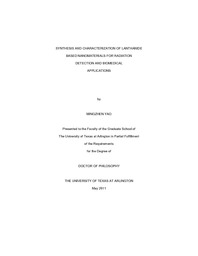
ATTENTION: The works hosted here are being migrated to a new repository that will consolidate resources, improve discoverability, and better show UTA's research impact on the global community. We will update authors as the migration progresses. Please see MavMatrix for more information.
Show simple item record
| dc.contributor.author | Yao, Mingzhen | en_US |
| dc.date.accessioned | 2011-10-11T20:48:54Z | |
| dc.date.available | 2011-10-11T20:48:54Z | |
| dc.date.issued | 2011-10-11 | |
| dc.date.submitted | January 2011 | en_US |
| dc.identifier.other | DISS-11056 | en_US |
| dc.identifier.uri | http://hdl.handle.net/10106/6182 | |
| dc.description.abstract | Lanthanide based nanomaterials have shown a great potential in various areas such as luminescence imaging, luminescent labels, and detection of cellular functions. Due to the f-f transitions of the metal ion, luminescence of lanthanide ions is characterized by sharp and narrow emissions. In this dissertation lanthanide based nanoparticles such as Ce3+, Eu3+ and other lanthanide ions doped LaF3 were synthesized, their characterization, encapsulation and embedding into hybrid matrix were investigated and some of their biomedical and radiological applications were studied.DMSO is a common solvent which has been used widely for biological applications.LaF3:Ce nanoparticles were synthesized in DMSO and it was found that their fluorescent emission originates from the metal-to-ligand charge-transfer excited states. After conjugationwith PpIX and then encapsulation within PLGA, the particles show efficient uptake by cancercells and great cytotoxicity, which is promising for applications in cancer treatments. However,the emission of Eu3+ in DMSO is totally different from LaF3:Ce, very strong characteristicviluminescence is observed but no emissions from metal-to-ligand charge-transfer excited statesas observed in LaF3:Ce in DMSO. Besides, it is very interesting to see that the coupling of Eu3+with O-H oscillations after water was introduced has an opposite effect on emission peaks at617 nm and its shoulder peak at 613 nm. As a result, the intensity ratio of these two emissionshas a nearly perfect linear dependence on increasing water concentration in Eu-DMSO, whichprovides a very convenient and valuable method for water determination in DMSO.Ce3+ has been well known as an emitter for radiation detection due to its very shortdecay lifetime. However, its emission range limited the environment in which the detectionsystem works. Whereas, Quantum dots have high luminescence quantum efficiency but theirlow stopping power results in very weak scintillation luminescence. Nanocompounds formedwith CdTe quantum dots and LaF3:Ce nanoparticles optimize both stopping power andscintillation efficiency based on energy transfer from LaF3:Ce to CdTe. Hybrid matrix materialssuch as ORMOSIL have superior mechanical properties and a better processability than puremolecular material which could be used as carrier of radiation material. Moreover, embedding alanthanide complex in a hybrid matrix enhances its thermal stability and luminescence output.LaF3:Ce doped ORMOSIL was synthesized by using two different LaF3:Ce, the nanoparticledoping concentration can reach up to 15.66% while its transparency and luminescent propertieswere maintained. These materials are very promising for radiation detection. | en_US |
| dc.description.sponsorship | Chen, Wei | en_US |
| dc.language.iso | en | en_US |
| dc.publisher | Physics | en_US |
| dc.title | Synthesis And Characterization Of Lanthanide Based Nanomaterials For Radiation Detection And Biomedical Applications | en_US |
| dc.type | Ph.D. | en_US |
| dc.contributor.committeeChair | Chen, Wei | en_US |
| dc.degree.department | Physics | en_US |
| dc.degree.discipline | Physics | en_US |
| dc.degree.grantor | University of Texas at Arlington | en_US |
| dc.degree.level | doctoral | en_US |
| dc.degree.name | Ph.D. | en_US |
Files in this item
- Name:
- Yao_uta_2502D_11056.pdf
- Size:
- 8.635Mb
- Format:
- PDF
This item appears in the following Collection(s)
Show simple item record


